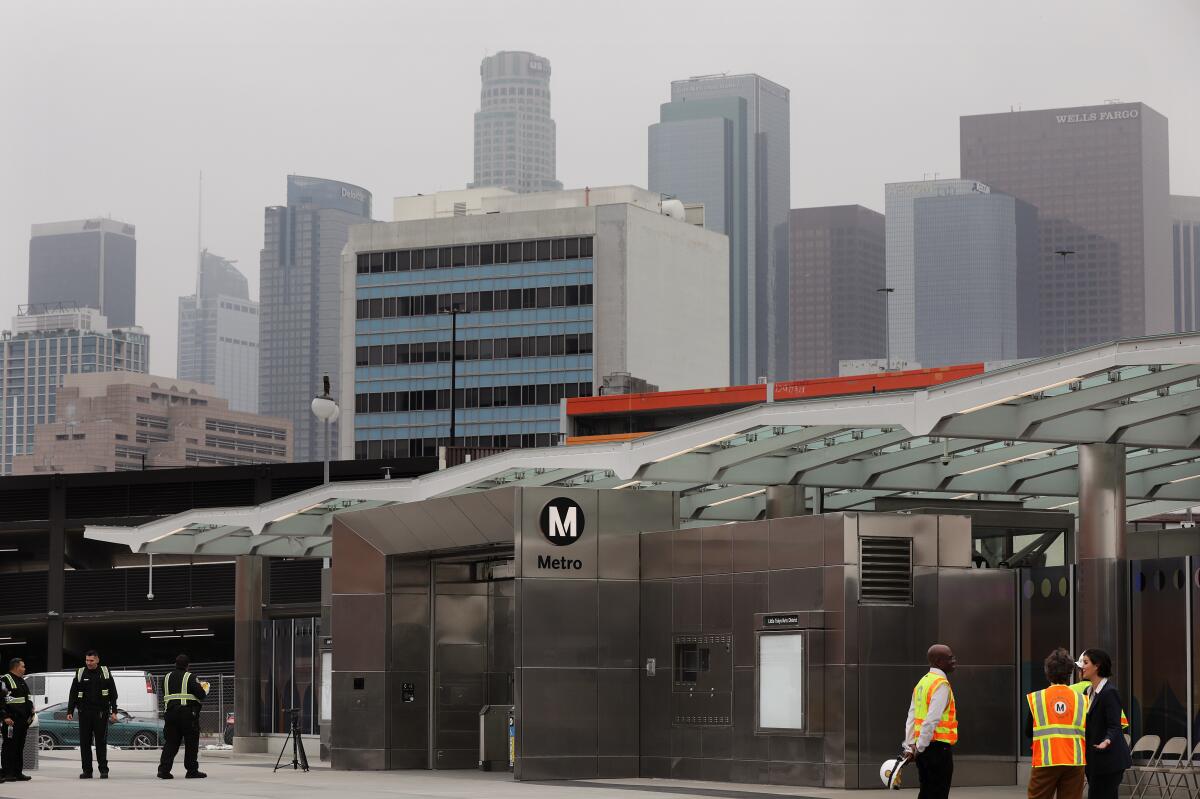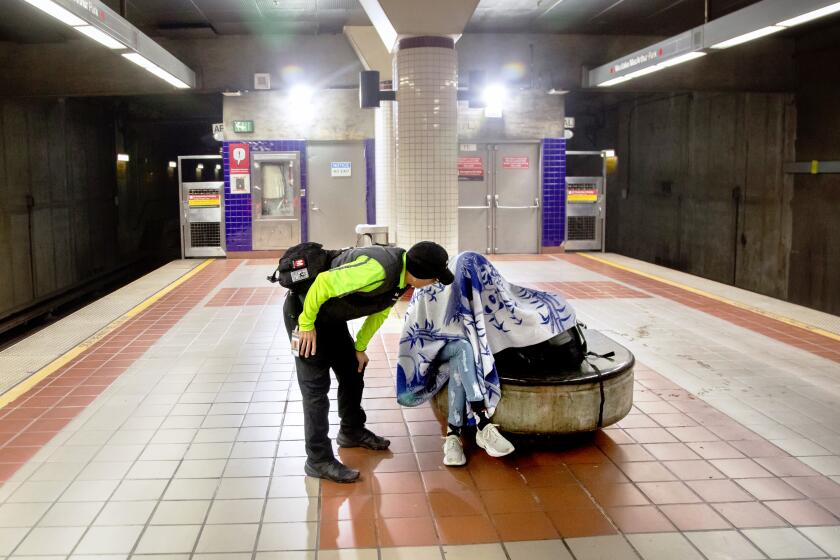Metro’s new downtown tracks can speed up your travel. Here’s what to know

- Share via
Anyone who rides Metro regularly is used to waiting for a train — just not for three years.
That’s how much extra time it’s taken Metro to finish the 1.9-mile Regional Connector, which opens Friday with three new stations to downtown Los Angeles. The main significance of the new line isn’t the extra stations, however; it’s the two major holes in the Metro system that the Regional Connector’s tracks plug.
For the record:
7:58 a.m. June 16, 2023An earlier version of this article reported that no transfer would be required to travel from Culver City to Union Station on the newly extended E line. The E line does not run through Union Station en route from Santa Monica to East L.A. It also misidentified the line running from Azusa to Long Beach as the E line. It is the A line.
Think of the connector as the glue between five sets of tracks that reach downtown L.A. It will take travelers starting to the north and northeast of downtown directly to points as far south as Long Beach, and travelers as far west as Santa Monica to stations as far east as East L.A.
So if you’re used to taking three trains to get from Pasadena to Compton, you’ll now ride just one: the newly elongated A (formerly Blue) line, which takes over the part of the L (formerly Gold) line that headed north from Union Station. Similarly, if you hopped onto three trains to get from USC to Mariachi Plaza, you’ll take just one: the E (formerly Expo) line, which takes over the part of the L line that headed east from Little Tokyo.
Here’s a quick guide to how the trips from various points A to various points B have changed.
More direct trips into downtown
One of the shortcomings of the Expo, Blue and Gold lines was that you couldn’t necessarily get to where you wanted to go in downtown L.A. without having to jump on a different line. The Expo and Blue lines ended at the 7th Street/Metro Center station after arriving from the west and south, respectively, while the Gold line went north and east from Little Tokyo.
Now, the reconfigured and elongated A and E lines will run through downtown, going from 7th Street/Metro Center to the new stations near 2nd and South Hope streets (dubbed Grand Avenue Arts/Bunker Hill) and 2nd Street and South Broadway (dubbed Historic Broadway) before reaching the relocated stop in Little Tokyo near 1st Street and South Central Avenue (Little Tokyo/Arts District).
Meanwhile, the existing downtown stations at 1st and South Hill streets (Civic Center/Grand Park) and 5th and South Hill streets (Pershing Square) remain in service for the B (Red) and D (Purple) lines.
Regional Connector opens June 16 in downtown Los Angeles, eliminating transfers while linking Long Beach to Azusa, East L.A. to Santa Monica.
More trips without transfers
Metro has emphasized how the Regional Connector turns the E and A lines into long, seamless tracks. The A now stretches nearly 50 miles from Azusa to Long Beach, making it the longest light-rail line in the country, Metro says.
Going the full distance from Santa Monica to East L.A. will take 1 hour and 9 minutes, and traveling from Azusa to Long Beach will take 1 hour and 58 minutes, according to Metro.
That’s great for the people who previously had to hop from the Gold to the Red/Purple to the Blue line to make that trip. But far more people will see quicker rides along considerably shorter distances because of the new, direct link between the former Gold line’s northern stations and the original Blue line, and the former Gold line’s eastern stations and new connections with the original Expo line.
The newly transfer-free rides include:
- Culver City to Little Tokyo
- East L.A. to USC
- Pasadena to Crypto.com Arena
- Highland Park to L.A. Trade Technical College
- Mariachi Plaza to Disney Hall
- Chinatown to Watts Towers
Metro is set to release a congestion pricing study this summer that looks at charging people to drive key freeways and roads.
Less friction means less waiting
Because Metro’s train lines serve different segments of the county, you may still have to hop from one line to another to get where you want to go. And with only six rail lines to serve all of L.A. County, you may have to switch from a train to a bus to get to your final destinations.
What the Regional Connector does, though, is reduce the number of times you’ll have to get out of one train and wait for another. For example, going by rail from Chinatown or Pasadena to The Times’ offices in El Segundo used to require three transfers. Now it will require one. Similarly, riding from East L.A. to L.A. Live used to require two transfers. Now it will just be one.
Metro workers watch and wait as drug overdoses unfold -- or go rogue to save lives. One has revived 21 riders.
New Metro fare limits
Starting July 1, Metro is capping the amount riders have to spend on any given day or over the course of a week. It’s also lowering the base fare for students and eliminating the extra charge to ride the J (Silver) line buses and Express Bus services.
With the introduction of fare caps, Metro is dropping its unlimited daily, weekly and monthly passes. Compared with the regular price of the passes, the caps will save money even for frequent riders. But the new fare structure will cost riders a bit more than the half-priced passes that Metro has been offering since the start of 2022.
To take advantage of the fare caps, you’ll need to get a Metro TAP card and prepay for some rides. To see a list of TAP card vendors, check the taptogo website.
If you already have a TAP card, you’re all set for the new fare caps. Remember to use the same card over the course of a day or week, because the caps are applied on a card-by-card basis. To obtain the lower fares Metro offers for seniors or students, you’ll need to submit proof of age or enrollment and obtain a TAP card registered with the discount program. You can apply online, by mail or in person at a Metro customer center.
The new caps are:
- $5 per day and $18 per seven-day period for riders ineligible for Metro’s discounted fare programs. The base fare remains $1.75.
- $2.50 per day and $5 per seven-day period for senior riders and those with disabilities. The base fare remains 75 cents during peak hours and 35 cents off-peak.
- $2.50 per day and $6 per seven-day period for students. The base fare for K-12 students is being reduced from $1 to 75 cents, and for college and vocational students from $1.75 to 75 cents.
For all riders, transfers to other buses or trains heading in the same direction will continue to be free for two hours.
About The Times Utility Journalism Team
This article is from The Times’ Utility Journalism Team. Our mission is to be essential to the lives of Southern Californians by publishing information that solves problems, answers questions and helps with decision making. We serve audiences in and around Los Angeles — including current Times subscribers and diverse communities that haven’t historically had their needs met by our coverage.
How can we be useful to you and your community? Email utility (at) latimes.com or one of our journalists: Jon Healey, Ada Tseng, Jessica Roy and Karen Garcia.
More to Read
Sign up for Essential California
The most important California stories and recommendations in your inbox every morning.
You may occasionally receive promotional content from the Los Angeles Times.

















